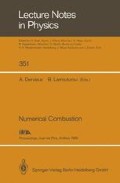Abstract
We solve the 2-D thermo-diffusive model of premixed flames in the framework of Fourier Spectral Methods. Although the temperature and concentration fields are not periodic in the direction perpendicular to the flame, we suggest a particular treatment, simple to implement, that is applied to these quantities in order to transform them into the sum of a known profile and a periodic unknown. This process also takes advantage of the fact that the physics of flames allows us to consider as periodic the higher derivatives. “Infinite” order convergence of Spectral Methods is thus recovered. This algorithm being very efficient, we can perform numerical simulation concerning the diffusive-thermal instability, far in the non-linear domain. Thus, at low Lewis number, we numerically observed, for the first time to our knowledge, a phenomenon of local extinction. This brings a plausible explanation to the presence of unburnt combustible in the lean hydrogen flame.
Preview
Unable to display preview. Download preview PDF.
References
Sivashinsky G.I.: Instabilities, Pattern Formation, and Turbulence in Flames. Ann. Rev. Fluid Mech. 15: 179–199 (1983)
Williams F.A.: Combustion Theory, The Benjamin/Cummings Publishing Company (1985)
Clavin P.: Dynamic behavior of premixed flames fronts in laminar and turbulent flows. Prog. Energy Combust. Sci., 11: 1–59 (1985)
Bregeon B., Gordon A.S., and Williams F.A.: Near-Limit Downward Propagation of Hydrogen and Methane Flames in Oxygen-Nitrogen Mixtures. Combust. Flame, 33: 33–45 (1978)
Sabathier F., Boyer L. and Clavin P.: Experimental Study of a Weak Turbulent Premixed Flame. Prog. Aeronaut. Astronaut., 76, 246–258 (1981)
Quinard J., Searby G. and Boyer L.: Cellular structures on premixed flames in a uniform laminar flow. In “Cellular structures in instabilities”, Lecture Notes in Physics, Weisfreid J.E. and Zaleski S. Ed., Springer Verlag, vol. 210, 331–341 (1984)
Denet B. and Haldenwang P.: A pseudo-spectral scheme for turbulent thermo-diffusive premixed flames. to appear.
Sivashinsky G.I., Non-linear analysis of hydrodynamic instability in laminar flames. Part I: Derivation of basic equations. Acta Astronautica. 4:, 1177–1206 (1977)
Mitani T. and Williams F.A., Studies of Cellular Flames in HydrogenOxygen-Nitrogen Mixtures. Combust. Flame, 39: 169–190 (1980)
Ashurst W.M.T, Peters N. and Smooke M.D.: Numerical Simulation of Turbulent Flame Structure with Non-unity Lewis Number. Combust. Sci. Tech., 53, 339–375 (1987)
Benkhaldoun F. and Larrouturou B.: A finite element adaptive investigation of two-dimensional flame front instabilities, to appear in Comp. Meth. in Appl. Mech. Eng.
Ehrenstein U., Guillard H and Peyret R.: Flame computations with a Chebyshev multi-domain method, to appear in Int. J. for Num. Meth. in Fluids.
Guillard H., Larrouturou B. and Maman N.: Numerical investigation of two-dimensional flame front instabilities using a pseudo-spectral method. INRIA Report 721 (1987)
Glowinski R., Larrouturou B. and Temam R.: Numerical Simulation of Combustion Phenomena; Proceedings, Sophia-Antipolis, France 1985, Lecture Notes in Physics 241, Springer-Verlag (1985)
Smooke M.D. and Koszykowski M.L.: Two-Dimensional Fully Adaptive Solutions of Solid-Solid Alloying Reactions. J. Comput. Phys., 62, 1–25 (1986)
Matsuno K. and Dwyer H.A.: Adaptive Methods for Elliptic Grid Generation, J. Comput. Phys., 77,40–52 (1988)
Buckmaster J.D. and Ludford G.S.S, Lectures on Mathematical Combustion, (SIAM-CBMS, Philadelphia) (1983)
Sivashinsky G.I., Diffusional-thermal theory of cellular flames. Combust. Sci. Tech., 15: 137–145 (1977)
Babuska I.: The p and h-p Versions of the Finite Element Method. A Survey. In: Proceedings of the Workshop on Theory and Application of Finite Elements (R. Voigt, M.Y. Hussaini, ed.) Berlin, Heidelberg, New-York Springer Verlag (1987)
Gottlieb D. and Orszag S.A., Numerical Analysis of Spectral Methods: Theory and Applications. (SIAM-CBMS, Philadelphia) (1977)
Canuto C., Hussaini M.Y., Quarteroni A. and Zang T.A., Spectral Methods in Fluid Dynamics. (Springer Series in Computational Physics, Springer-Verlag) (1988)
Author information
Authors and Affiliations
Editor information
Rights and permissions
Copyright information
© 1989 Springer-Verlag
About this paper
Cite this paper
Denet, B., Haldenwang, P. (1989). A local extinction of the thermo-diffusive premixed flame at low Lewis number. In: Dervieux, A., Larrouturou, B. (eds) Numerical Combustion. Lecture Notes in Physics, vol 351. Springer, Berlin, Heidelberg. https://doi.org/10.1007/3-540-51968-8_86
Download citation
DOI: https://doi.org/10.1007/3-540-51968-8_86
Published:
Publisher Name: Springer, Berlin, Heidelberg
Print ISBN: 978-3-540-51968-3
Online ISBN: 978-3-540-46866-0
eBook Packages: Springer Book Archive

